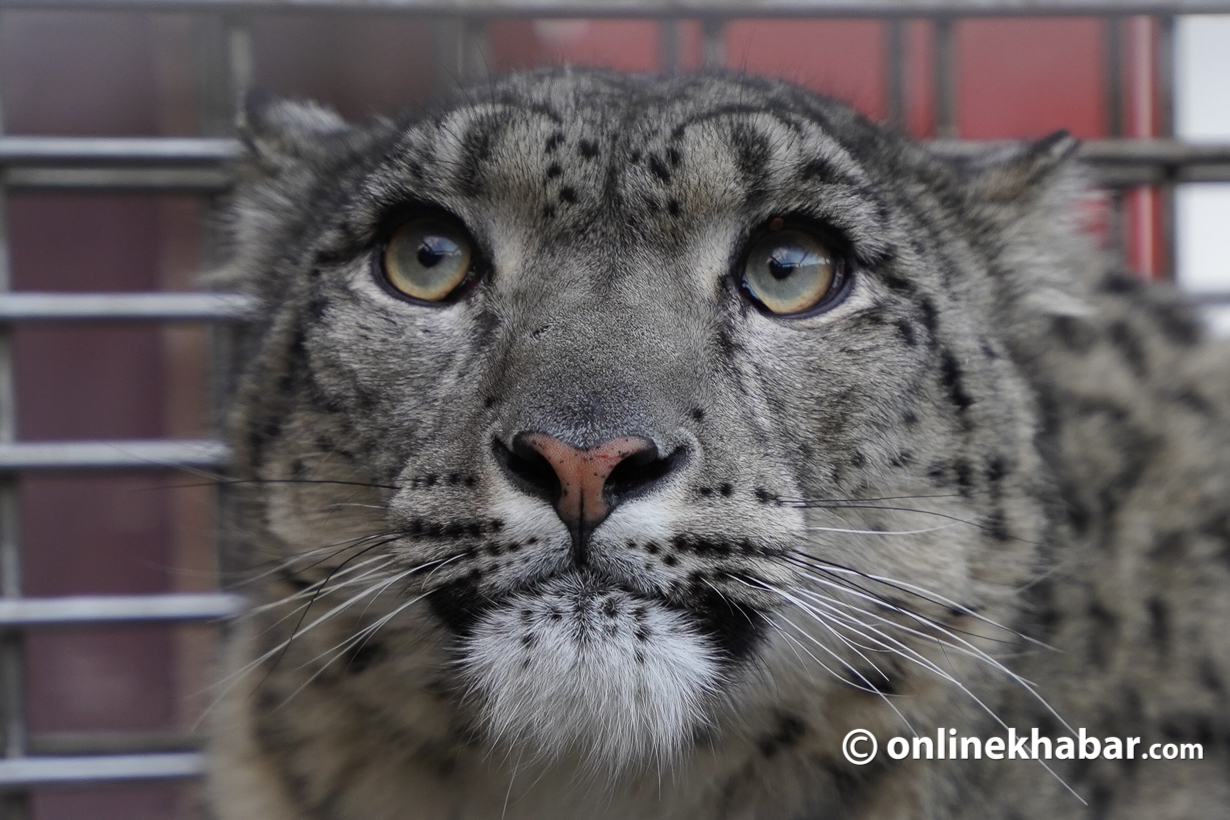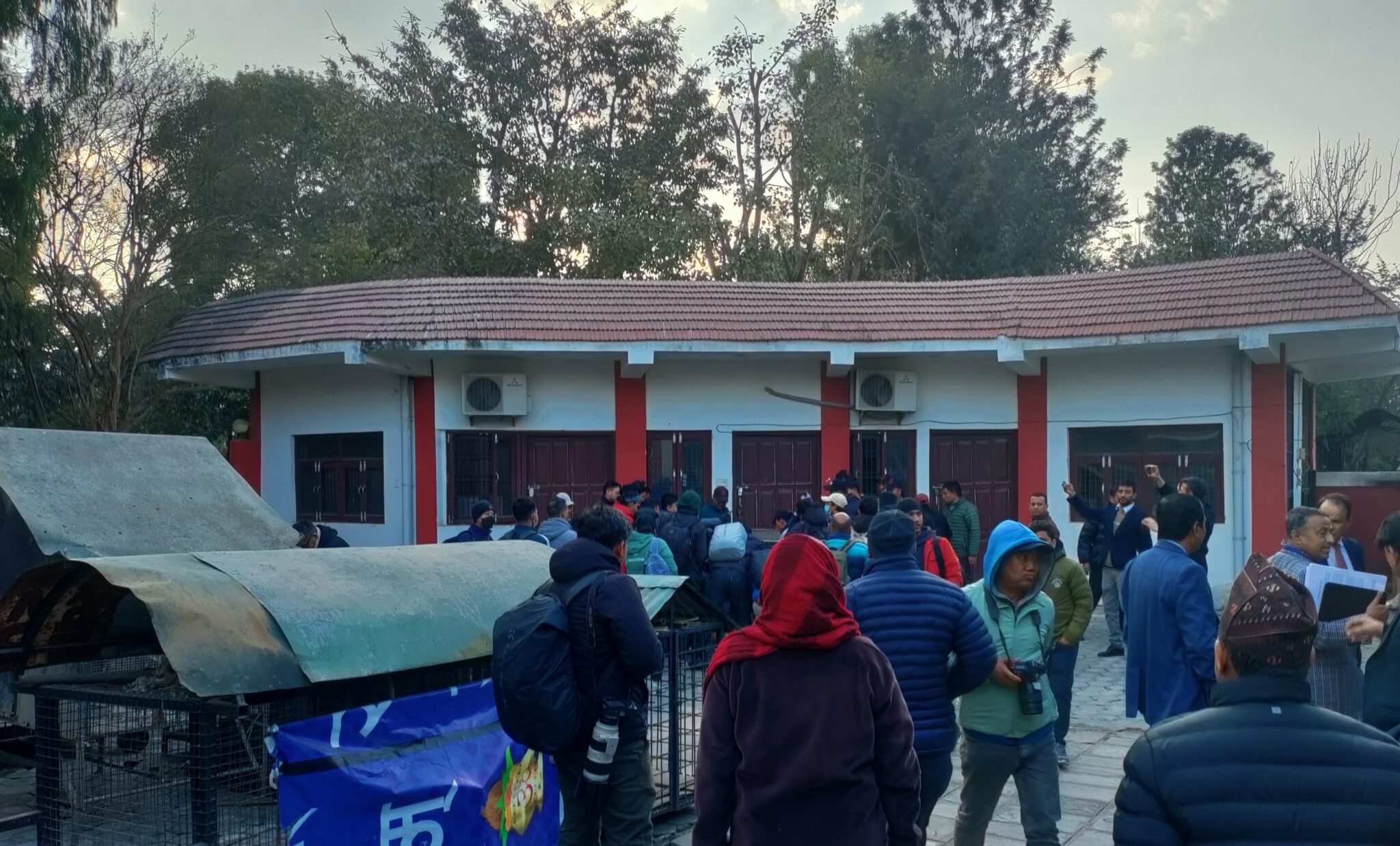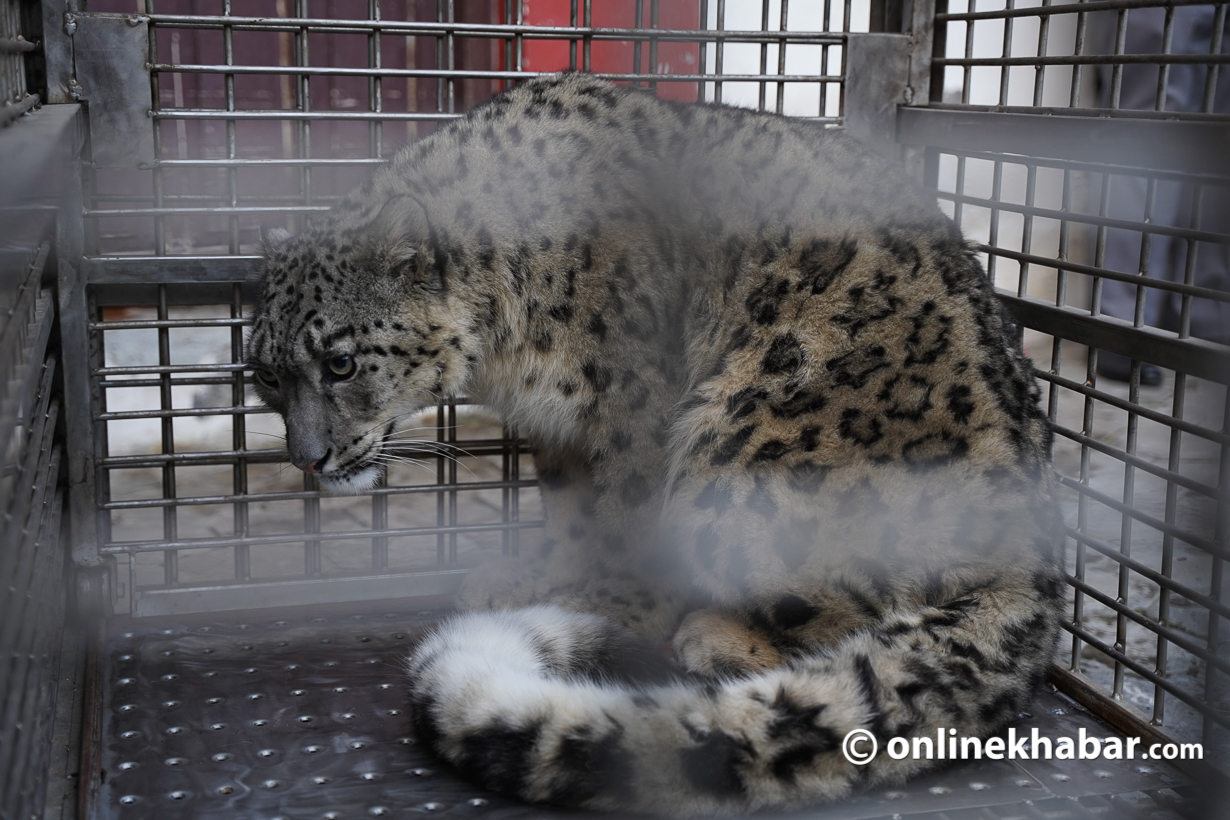
As the gates to the vet clinic at the Central Zoo in Lalitpur opened, more than two dozen photojournalists thronged the facility and surrounded a metal cage aiming their DSLR cameras at a snow leopard inside.
“Please don’t come close to the animal,” the zoo’s vet, Radha Krishna Gharti, told approaching photojournalists. But in the gush of excitement to take exclusive photographs of the elusive cat, difficult to spot even in its prime habitats, there were few takers for the word of caution.
Nepal’s Department of National Parks and Wildlife Conservation (DNPWC) organised the photo-op two days after the male subadult cat, which was until recently found in the country only at altitudes higher than 2,000-6,000 metres above sea level, was brought to the zoo from Urlabari town(146 m above sea level). According to the department, the animal has sustained injuries to its right foreleg and cannot stand upright.
Although officials involved said they are looking at releasing the animal into the wild after it recuperates, doing so will be a daunting task, adding that the zoo may be the only place where it can now survive.
Not a wild cat

“Nepali snow leopard experts have come up with two hypotheses to explain how the animal from the mountains landed up in the plains,” said Sharad Chandra Adhikari, member-secretary at the National Trust for Nature Conservation (NTNC), a semi-government body that manages the zoo in Lalitpur, a town in the Kathmandu Valley.
The first of the two hypotheses made public during the photo-op-cum-press conference, is that it was raised in captivity and somehow managed to escape into the wild. The second is that it lost its orientation while trying to establish its territory after separating from its mother.
Kulbhushansingh Suryawanshi, director of the India program, Snow Leopard Trust, said that both hypotheses are plausible explanations as to how the snow leopard got to the plains in Nepal.
A DNPWC official, who wished to remain anonymous as he is not authorised to talk to the press, said that it was more likely that the animal had been raised in captivity.
“The way it sipped the water and ate the food zoo staff offered indicates that it may have been raised in captivity,” the official said.
Snow leopards are shy cats living at extreme altitudes in the steep mountainous areas of 12 countries in Central and South Asia. Their global population spread over altitudes of 500-5,800 m, is estimated to be between around 3,900 and 6,000 as detailed coordinated surveys of the population in the range countries are yet to be carried out. In Nepal, their population divided into three blocks (eastern, central and western) is estimated to be between 301 and 400.
Adhikari from NTNC said that researchers will now examine the animal’s scat to analyse its diet and try to find out whether it was roaming in the wild or had been in some sort of captivity. Researchers are also preparing to analyse its genes to try to find out to which of the three metapopulations in Nepal it belongs. They will also observe the animal’s canine teeth and fur to look for clues.
Relocation challenge

The whole process could take a few months to complete, and summer could set in in Kathmandu by then, officials concede.
“The current temperature in Kathmandu is suitable for snow leopards, as we are in the peak of winter,” said Madhu Chetri, a snow leopard researcher from NTNC. But that could change as spring season begins in the Northern Hemisphere.
The DNPWC official said that regardless of the findings related to how the animal got to Urlabarli, the animal would have spent a significant amount of time with humans during its recovery phase. “That would mean that it would have gotten habituated with having humans around,” the official said.
Sending such animals back into the wild is a challenge, as they may have lost their hunting and other adaptation skills, he added. In May last year, officials at the Chitwan National Park released two rescued rhino calves into the wild, with limited success. The safety of the animals, which had gotten used to having humans around, was compromised as poachers could easily approach and kill them. Eventually, they were transferred to an enclosure in eastern Nepal away from human intervention.
Veteran conservationist Professor Karan Bahadur Shah said that rewilding the snow leopard would be a daunting task, as the animals are territorial. “If we just leave the animal in its natural habitat, it will get killed by other snow leopards defending their territory,” he said. “The best option would be to keep the animal in the zoo for the public to see.”
But Nepal’s Central Zoo has its own set of problems. The facility, established in 1932 as a private collection, has limited space and has frequently run into financial trouble. Conservationists say the snow leopard would need special facilities to cater to its needs.
“If the government decides that the snow leopard needs to remain at the zoo, we are ready to shoulder the responsibility,” said Adhikari. “We have set up special facilities for animals such as the red panda and chimpanzees,” he said. “We can do that for the snow leopard as well.”
Those advocating for keeping the animal in the zoo also said that Nepal is a snow leopard range country and the public, especially the young generation, also needs to see the different animals found in the country. “It has great educational value,” said Shah.
Snow leopard expert Suryawanshi from neighbouring India also said that it would be challenging to release the animal into the wild.
“If the team at the zoo can establish the exact cause of this behaviour [why it ventured into the plains] and can keep the animal away from human contact, then it might be okay to release it back,” he said. “But otherwise, there is little hope for it in the wild. Better to let it live in the zoo.”
Back at the zoo, after the photojournalists are done taking photos, it is the turn of the reporters to point their smartphones at the animal. Then there is a contingent of senior wildlife department officials waiting in line to catch a glimpse of the animal.
“So much for keeping it away from human contact,” a conservationist observing the hullabaloo from a distance said.
This story first appeared on Mongabay and Onlinekhabar is republishing it under a Creative Commons licence.
























